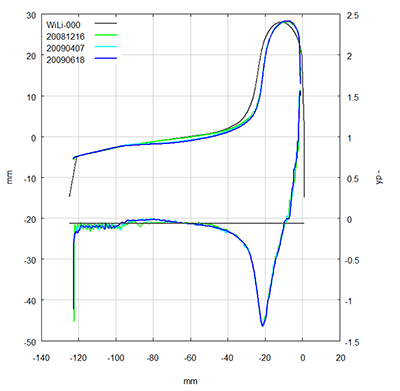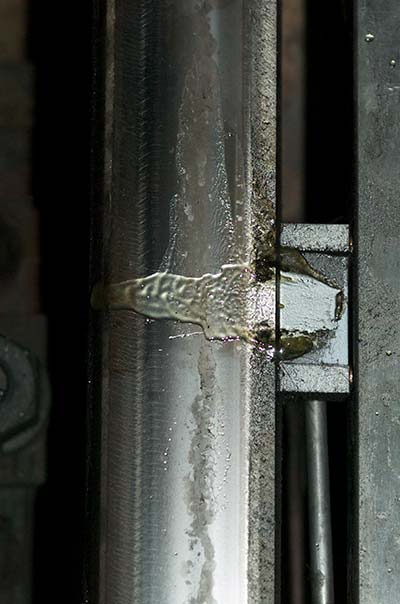IonicRail – Systemic Rail Head Conditioning by Alternative Lubricants like Ionic Fluids and Application Equipment
03/2009 – 08/2011

Temporal evolution of a wheel profile

Tribological measurement of the rail friction

Distribution of the conditioning lubricant on the rail surface, right after application
Rail head conditioning serves to apply a defined coefficient of friction on the surface of the rail head. Effects mainly attributed to the wheel-rail contact comprising unpleasant acoustic effects (e.g., friction noises and squeaking) and wear (debris and the modification of the wheel and rail profiles) shall be reduced or avoided. Moreover, a constant traction between wheel and rail is to be provided. For this purpose, oils, greases and solid lubricants such as graphite can be applied. Due to environmental reasons, conditioning lubricants are mainly based on canola oils.
Lubricants currently in use suffer from a couple of disadvantages, in particular from the low range and insufficient durability of the lubricating film. Consequently, there exists a demand for the optimization of the application technique.
The project IonicRail investigated feasible methods for the supply of the rail head with lubricants with consideration of particular operating conditions (contact mechanics, environment) and lubricant performance. Using the proposed systemic approach, novel lubricant formulations were designed and investigated. Special attention was paid to the group of ionic liquids, which are characterized by various unique properties, such as tailor-made viscosity/temperature behaviour, negligible volatility, low inflammability and high thermal stability. Currently, ionic liquids are intensively investigated for several potential applications as lubricants.
In addition to the simulation of selected (tribo)-contact situations, fundamental analyses of the lubricant technology of conventional conditioning lubricants were carried out in order to obtain detailed information of the chemical composition. These measures aim at the discrimination and correlation of the experience in the field with chemical-physical properties and results from simulation. Analyses and simulations provided the foundations for the catalogue of requirements defined for alternative rail head lubricants and the design of tribometrical model experiments.
As a result of the catalogue of requirements, appropriate research methods and lubricant technologies were deduced. Tribometrical model experiments were crucial for the pre-selection of potential candidates for the rail head lubrication. This was followed by the investigation of the most promising lubricant candidates in field tests. In addition, an LCC estimation was carried out.

